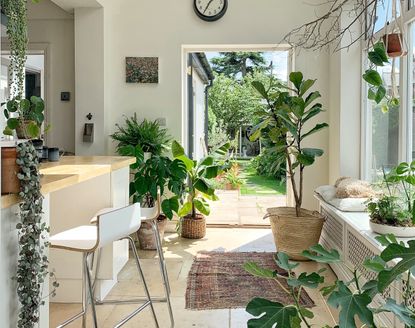

If you're in need of a little apartment therapy, indoor gardening is the answer. Growing your own herbs, plants, vegetables and more inside is perfect for anyone craving a closer connection with nature and wanting to live a little more resourcefully. What's more, pulling your green thumb out inside is of course a saving grace for those without a garden and, it can still work if you're short on space also.
Whether you want to use classic yet clever hydroponics or DIY your own green space setup in a tiny corner of your kitchen or even bedroom, we have the inspiration you need to invite the best indoor plants and a little more nature into your surroundings.
We spoke with the experts at Essential Living about why indoor gardening is so revolutionary and the best ways to get started if you're a total novice. 'Whilst many of us love living the high-rise apartment life, a personal garden space is a sacrifice you have to make, and one in eight Brits are currently living without a garden. Gardening is a great way to destress and being surrounded by plants and nature is proven to lower stress levels and improve our mood. So, just because you have no garden, it doesn’t mean you can’t put your gardening skills to the test!'
When is the best time to start an indoor garden?
'Spring, is the perfect time to plant seeds and start growing your own garden indoors. During spring plants get the best conditions they need to begin to grow because spring gives a mixture of sun and rain. The rainwater gives them the hydration they need and longer days means more daylight and warmth from the sun, helping raise temperatures of both the air and the soil.'
1. Start indoor gardening with herbs
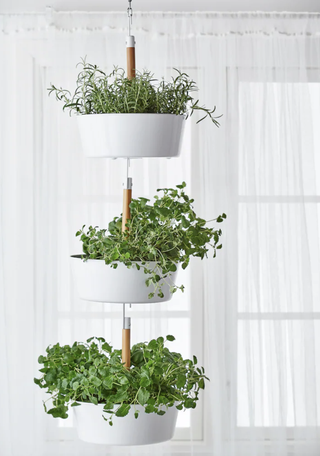
Herbs, naturally, have so much texture to them, and with the added bonus of being both edible and fragrant also, an indoor herb garden is a great starting point for beginners.
Save space and make them even more of a feature in your kitchen with a tiered pot display like the Ikea Bittergurka – perfect if you have a tiny kitchen and need to save valuable worktop space. You can hook together as many as you need, and then when you need to use them in your cooking or want to have them on hand to garnish your dinner, just can just unhook your herb of choice and pop it on the table.
Mint is a lovely and east herb to start with, 'Fortunately, growing mint indoors is pretty easy. You can do it either in a pot of soil or even in a bottle of water and you need to make sure you have a container with sufficient drainage for healthy plant growth. For soil growth, pot up your mint plant with a good potting mix- a normal one containing peat is fine- and water the mint plant well after planting. Place it in an area with indirect light, preferably an east-facing window during spring and summer. Try maintaining an indoor temperature of around 65-70 degrees for the best results.'
- If you are after more small kitchen ideas check out our gallery.
2. Try your hand at hydroponics
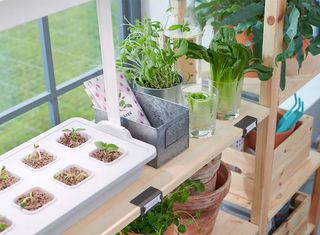
Starting your own indoor nursery is the way to go if you're serious about creating a thriving indoor garden. Hydroponics and indoor cultivation units will let you grow all sorts of plants and vegetables from seed, through to when you can harvest and (hopefully) eat them, all year round.
These types of units are super modern looking, and will even give you extra lighting if you choose the white light, so they look great in contemporary spaces, and won't take up much room either. All you need to get started is some seeds and a growing kit such as the Växer from IKEA.
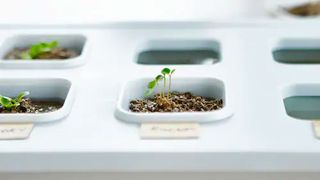
3. Give plants and vegetables the right growing environment
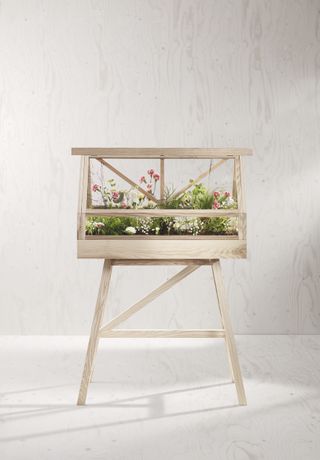
This miniature greenhouse would also make a great option for an indoor herb garden
A greenhouse is a gardener's best friend, both indoors and out! Perfect if you want to grow your own and start veggies, fruit and herbs or even flowers off from seed as a greenhouse helps with humidity and temperature levels, stopping seeds drying out. This miniature greenhouse, with it's simple structure, would also make an eye-catching addition to any style of home, so it's a great option for growing and showcasing your greenery, letting you bring the magic of nature indoors.
4. Use small spaces to grow veg from scraps
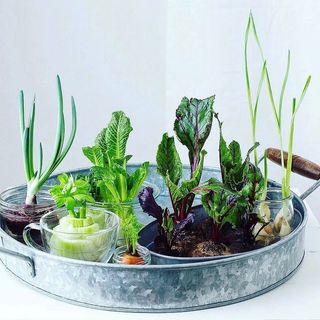
'Growing vegetables has become extremely popular, and you can even regrow your veggies from scraps.' All you need is a bowl, your leftover vegetables and the right technique for lift off. 'If you want to grow mint plants in water, simply take tip cuttings of about 5 to 6 inches in length from an established mint plant. Remove the bottom leaves and place the cuttings in a water-filled glass or bottle. Set this in a sunny window with at least four to six hours of light each day.'
- Our vegetable gardening guide has all the info you need for this technique.
5. Use trailing plants to DIY an indoor living wall
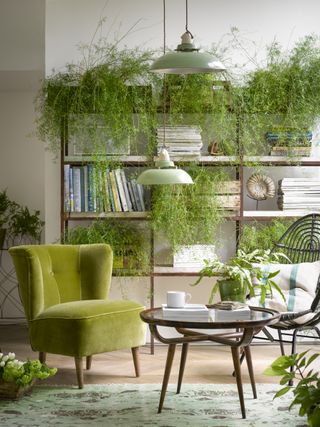
Spider plants, with their trailing tendencies, are a great alternative to consider if you're trying to recreate this look
If you're not fussed about an edible indoor garden, then rest assured that there are so many types of gorgeous indoor plants out there . But if you're looking for a dramatic indoor garden look, similar to that of an outdoor living wall, then you should look to trailing house plant varieties.
Adding living, breathing greenery to your space will instantly perk up the atmosphere – and, not to mention cleanse the air. We love this look for a great alternative to the more traditional gallery wall, and again, if you're short on space and working with a small living room or other area of your home, adding texture will actually. amplify the space you do have.
- See all our vertical garden ideas for inside and out.
6. Cluster large house plants to create an indoor jungle
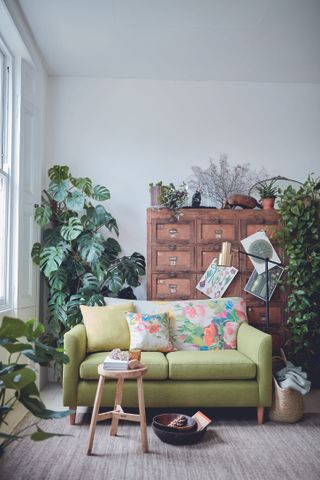
Find this Brionna two-seater sofa at DFS
Want your home to have a raw and vibrant feel to it? Create a (controled) indoor jungle with oversized plant life. We'd recommend a humungous Swiss cheese plant as a great starting point and be sure to cluster your plants together for a mega display which will keep yours plants happiest too!
- Find out how to care for house plants properly in our guide.
7. Favor air-purifying plants
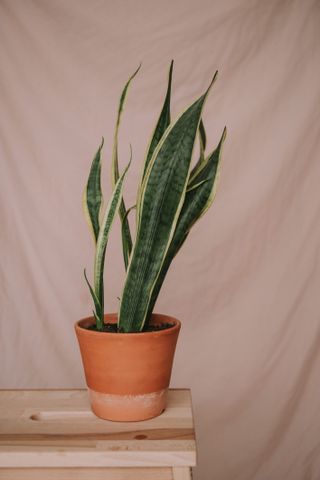
Speaking of fresh air, not only can adding greenery and gardening indoors do wonders for your mental health but it can also be really beneficial to your physical health. The benefits of house plants are endless but one that tops them all is their capacity to rid the surrounding air of toxins by absorbing CO2.
'Snake plants can absorb and remove harmful toxins from the air, including CO2, benzene and xylene and can act as an effective defence against airborne allergies- particularly great for those allergy sufferers!
To plant, first start by choosing a pot with a drainage hole in the bottom, like a terra cotta pot which works well as they allow the soil to dry out more easily than plastic pots.
For your potting mix, use one which is good for draining and designed for “cacti and succulents” as it will be more resistant to becoming oversaturated with water. Remember not to pot your snake plant too deep.
Snake plants prefer bright, indirect light and can even tolerate some direct sunlight however, they also grow well in shady corners and other low-light areas of the home, which gives you the flexibility of where you want your plant to live. Try to keep it in temperatures above 10 degrees.'
8. Create a tiny terrarium
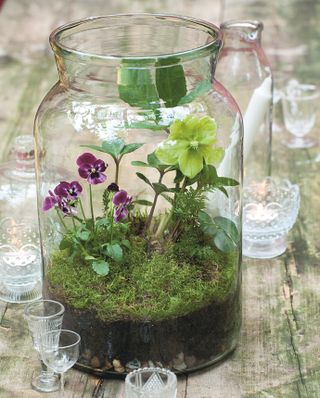
Available in a variety of quirky shapes, terrariums are a simple addition to a sad looking space. We love the unique shape of this Gold Terrarium from Not on the High Street
Terrariums are incredible things. Cute and complete with their own living and self-nourishing eco-system, pretty remarkable eh? So, if it's all about the detail in your space, then this is the indoor garden idea for you. Fill yours with succulents, moss and the like, and see how it makes the perfect addition to a home office, lonely windowsill or even bedside table.
'A terrarium is great for those looking for a simpler way to enjoy gardening thanks to their fuss-free maintenance and minimal space requirements, meaning they're great for gardeners who lack outdoor space
This beautiful home accessory is ideal all-year-round and whilst it is simple to make, you can be as artistic as you want. All you need is a glass container, soil, some greenery, and a pinch of creativity to turn a vessel into a miniature landscape.'
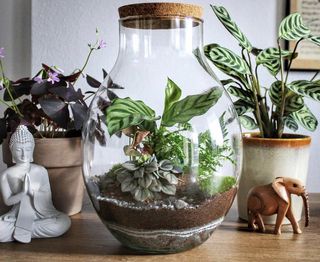
- Use our step-by-step guide to find out how to make a terrarium.
9. Hang house plants for a 360-degree display
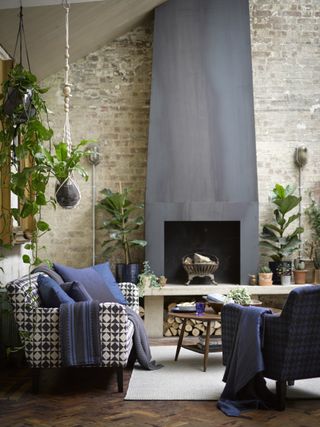
This Lily Three Seat Sofa from Sofa.com adds to the homely feel of the space
If you're blessed with high ceilings, this makes the perfect platform for indoor gardening with taller plants. Choose more dramatic species or equally eye-catching trailing varieties for an all-round stunning display.
10. Start small with succulents
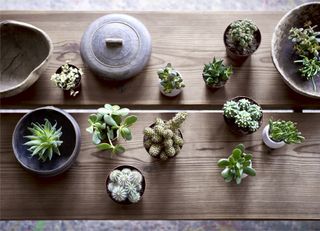
An assortment of pots really adds to the eclectic feel of this house plant display. Find similar at Ikea
One of the more easy plants to keep alive, succulents come in all shapes and sizes, and they deserve some space in every indoor garden especially if you are a beginner. Not only are they beautiful, but they are also super hardy so you won't be killing these any time soon. Bring a coffee table to life or jazz up your home office space with an assortment of species, sizes and pot style and you will not regret it.
11. Transition plants throughout your rooms

Whether you use wicker baskets to store logs, blankets or children's toys, consider keeping one for an injection of greenery
Remember to spread your indoor garden out around your house, flat or studio as this will give it the ultimate lift. After all, the beauty of an indoor garden is that you can keep it very much on wheels. So if you're renting and likely to move soon, you won't have to leave anything behind. Wicker baskets work as a great home for house plants and we love the neutral and rugged look these bring to this minimal bathroom above. Find similar storage baskets at House of Bath.
12. Fill up shady corners with tropical plants
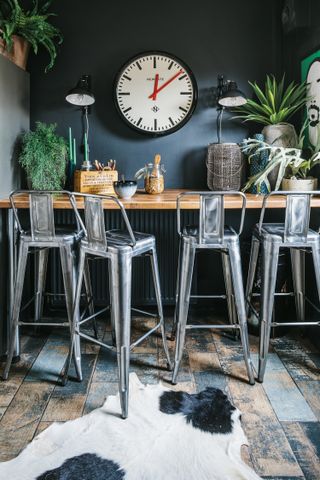
This breakfast bar is the perfect example of making use of a dimly lit space. Packing corners in with lots of humid and shade-loving plants like ferns and spider plants will actually help create their perfect environment.
13. Display your indoor garden up the wall
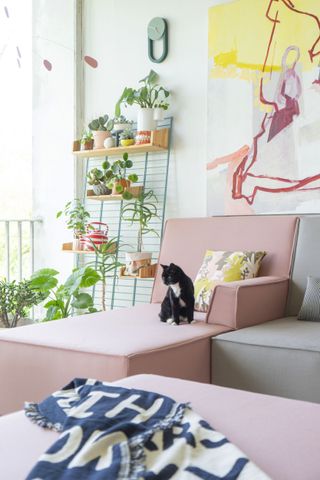
For a similar two toned sofa, take a look at Cubit
Styled with blush tones and a varied assortment of plant life, this space has a really beautiful feel to it and is a great use of space. Propped up against the wall, this light blue wire rack offers a simple solution for growing seedlings, small house plants and the likes. Acting as an eye-catching focal point within the space, this is how to create an indoor garden come feature book shelf. To achieve a similar look, try Etsy
14. Grow strawberries inside
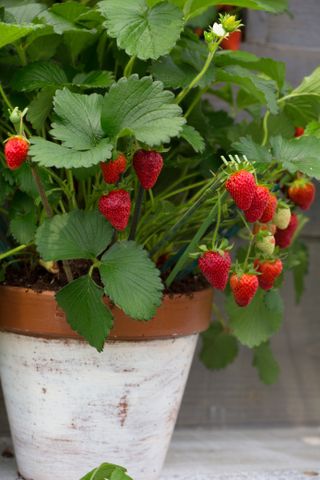
You don't need a garden to grow strawberries and they will do well in a window box on a window sill or even hanging from the ceiling. 'Alternatively, a windowsill can also be used, but be sure not to overcrowd the plants as they can become vulnerable to disease or mould. The key ingredient to growing strawberry houseplants is sun exposure, whether indoors or out, strawberries need at least six hours of sun per day.'
15. Create more dappled light
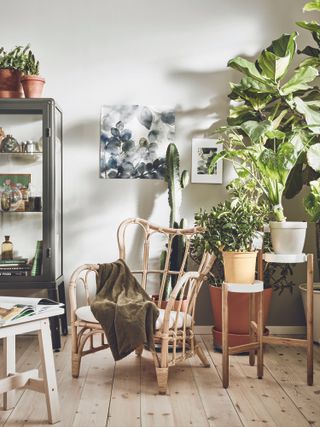
We love the Satsumas Plant Stand from Ikea
Make best use of different levels and you'll draw the eye up, to add loads of height and interest to your surroundings too. While smaller plants can look better clustered together, creating a little space between larger varieties is a great way to display them and to create more dappled light for any sensitive vegetable seedlings or shade-loving house plants around. Experiment with the positioning of indoor plants to find a combination that works for you.
16. Grow in your home office
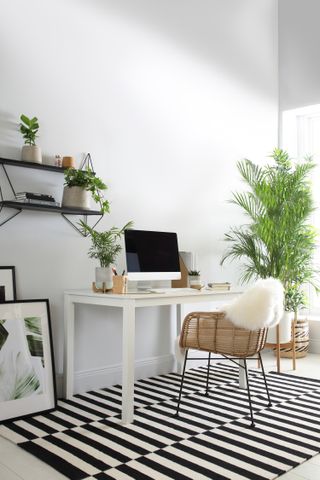
It has been suggested that plants increase happiness and productivity, so including them in a home office seems like an obvious choice
Plants work wonders to create a more zen feel in a WFH space and they can help create the perfect environment too. Let them cleanse the air, and help break up any harsh midday sun glaring on your computer screen with a big house plant that will happily dapple the rays for you.
17. Group plants for easy care
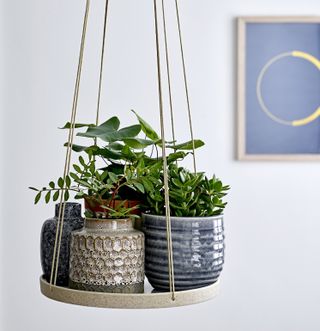
For similar neutral toned, ceramic plant pots, try Beaumonde
To keep your indoor garden easy to manage, grouping house plants that have similar needs in terms of light, humidity, temperature and water needs, is a great idea. Not only will it look great, but there will be less to-ing and fro-ing between pots with watering can in hand. In some cases you can even plant house plants, in the same pots, similar to companion planting in outdoor gardening, as they will live simply live together in sweet harmony.
How do I start an indoor garden for beginners?
'Indoor gardening is great for those living in the city who lack garden space. Whilst those living in apartments may not know where to start, there are only five things you need to consider, space, light, temperature, soil (potting mix) and plant type.
Plants don’t need to take up much space and a sunny windowsill, shelf, tabletop, or if you are lucky enough to have a balcony is all it takes. Whilst planting on a windowsill will help provide your plants with the most natural sunlight, you may struggle for space. For beginners who want to start off growing one or two plants, shelves are great for small spaces as they provide lots of planting room and only take up mostly vertical space.
Light is also very important as you need to ensure your plants have a sufficient amount for healthy growth. A lack of light will cause your plant to grow too tall and topple over. If you struggle to grow plants in natural sunlight, you can use artificial grow lights including incandescent bulbs, high-intensity discharge bulbs, fluorescent bulbs or LED. Always remember, the light should be positioned as close to the plant as possible, without being so close as to burn the leaves. Ideally a few inches above seedlings for best results.
In terms of temperature, 18-24°C (65-75°F) are ideal for most plants, and temperatures a little bit outside of this range won’t do any harm. One of the biggest issues with growing indoor plants is a lack of humidity, which is why misting your plants daily with a spritzer will help lock in that moisture.
Ideally, when choosing your potting mix you want one suitable for indoor gardening. Try to avoid using regular garden soil as it can cause contamination of bacteria and bugs which can hinder your new seedlings from growing properly. A good seed starting mix has a fine texture, almost loose, light and fluffy and should contain enough organic matter to provide nutrients and to hold the moisture but also drain well.
There are more things you can grow indoors than you think, so try to broaden your horizons but also choose something you love if it is your first time growing indoors. You can choose a range of vegetables including salad greens, chilli peppers, cherry tomatoes and runner beans.
For cooking, herbs such as basil, parsley, rosemary, chives and oregano are also great for indoor growing. Many flowers do well indoors including African violet, cactus, peace lily etc. just make sure you check the light requirements before you grow.
The best fruit to grow indoors are definitely strawberries, and even though they take up to two months to fully grow, they taste just as good knowing you grew them yourself! they are though they take.'
How do I set up an indoor vegetable garden?
'Most herbs will grow easily indoors, but when it comes to vegetables, some are better suited than others. The best veg to grow include, tomatoes, arugula, bell peppers, mushrooms, beans, kale, carrots, sprouts, radishes, spinach, lettuce, potatoes.
Start by setting up the right environment for your vegetable. Whilst natural sunlight is great for any plant growth, indoor veg grow best under full-spectrum LED bulbs as they use significantly less power to produce more light and less heat- recommended for veg growth.
Next, you need to choose a container, and you make use of any items you have lying around at home such as plastic yoghurt tubs, toiletry bings, old shoes, egg cartons. Just make sure they are full of dirt and have a hole at the bottom. In preparation for planting, add a bit of gravel to the bottom of the container to encourage drainage and if you don’t have gravel you can use bits of concrete/marbles or a handful of rocks- anything that will soak up moisture.
Then you just need to plant, and if you’re starting your indoor garden from seeds anything like this Seed Starter Kit is ideal, cheap and easy all you need to do is add water.
Normally vegetables will reach peak growth between 1-2 months, depending on what you’re growing, and for maintenance generally an inch of water per week, either by rain or watering is recommended. In hotter weather, vegetables will need up to about ½ inch per week extra.'
Start sowing 🌿s inside
Join our newsletter
Get small space home decor ideas, celeb inspiration, DIY tips and more, straight to your inbox!

I'm Cam, the former deputy editor of Real Homes who worked on the site from 2020 to 2023. As a renter myself, sharing a home with two friends (and my cat) in London, I know all too well the challenges that this can pose when it comes to creating your perfect setup. As someone who has always loved everything interior design-related, I cannot rest until a home feels right and I am really passionate about helping others get there too, no matter what their living situation, style, or budget may be. It’s not always the easiest to figure out, but the journey is fun and the results are so worth it.
After interior design, travel, art, and photography are my next big passions. When I’m not writing or editing homes content, I’m usually tapping into other creative outlets, exploring galleries in London or further afield, taking photos, scribbling, or drawing!